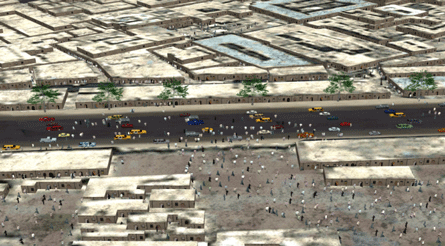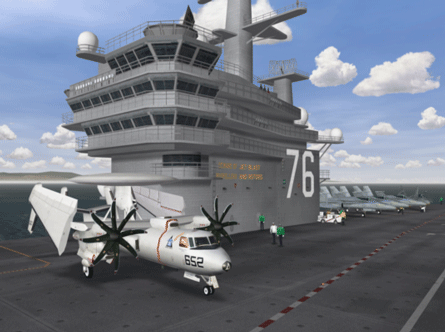The drive to reduce training costs coupled with an increasingly complex battlefield environment is driving the defence industry to step up the level of realism and interconnectivity of its simulator products.
In a new generation of simulators now emerging, navy and marine carrier pilots can taxi from the parking spot to the catapult on carrier decks that are as hectic and cluttered as the real thing.
Similarly, air force and army troops in far-flung locations will be able to fight together in virtual cities that have thousands of inhabitants and vehicles that use artificial intelligence to act naturally as the non-scripted events unfold.
"Every customer we talk to continues to emphasise the importance of making the trainees feel like they're in the real environment," says Ken Schreder, vice-president and general manager of simulation and training for Rockwell Collins.
The company supports simulation needs, from manuals through to full-immersion flights and mission simulations, for a variety of US and international military customers, including the US Navy for the new Northrop Grumman E-2D Advanced Hawkeye.
 |
|---|
© L-3L-3's HD World allows multiple users to see the same environment, with virtual people reacting to events |
The E-2D contract, won by Rockwell Collins in August, will incorporate the three main trends driving simulation upgrades in the defence simulation sector today: interoperability, to allow the services to rehearse and perform missions synchronously an open architecture that provides for scaleable solutions and reuse of the various elements throughout the training regime and increased visual realism through advanced hardware, software and databases that can be rapidly updated in response to an evolving environment.Rockwell Collins will provide a full-motion pilot training device as well as aircrew, tactics and maintenance trainers, delivering the entire system for use six months before the command and control platform's initial operational capability in 2011.
MACRO SCALE
Interoperability on a macro scale means that the E-2D will be capable of tying into the US Department of Defense's high-level architecture - a distributed missions operations network (DMON) that will allow it to operate synchronously with other military simulators for real-time virtual training exercises.
While the military already performs joint simulations on a regular basis, the realism of these events is limited. "The issue with the distributed mission exercises is that when they try to link all these different platforms and training systems, each typically has a different pedigree of capability depending on when they were fielded," says Frank Delisle, vice-president of engineering and technology for L-3's Link Simulation and Training division.
"Many don't have the fidelity that is the same, and when they run the joint exercise, a correlated experience where they desire to see the same physical world, it is a near impossibility."
L-3 supplies a variety of simulation products to a large number of US and foreign militaries, including training for US Army pilots as part of Flight School XXI, a CSC-led fee-for-service simulator-based training programme at the service's Fort Rucker training facility in Alabama.
L-3 will also provide fee-for-service training for the army and air force L-3/Alenia North America C-27J Joint as part of the company's contract to build the twin-engine turboprop for them. As a result of the lack of fidelity, joint operations are forced to run at "the lowest common denominator," says Delisle, "and the LCD is pretty low." That means most of the shared eleemtns are typically air assets and exercises focus on high level co-ordination only.
 |
|---|
© Rockwell CollinsThe latest simulators give pilots the feeling of taxiing to the catapult on crowded carrier decks |
The air force is working to raise the LCD, in part to allow a more diverse user base for more realistic mission training. Col Jack Franz, commander of the US Air Force's 677th aeronautical systems group, says interoperability is a major priority for air combat joint exercises. "We're trying to bring in all aspects of the kill chain into a 'Red Flag' or a live-flying event," he explains.
According to the air force the 677th is responsible for delivering secure networked simulation capabilities that "enable mission rehearsal and realistic operational environments".
JOINT MISSION
While pilots and air crew at a limited number of sites can already perform joint mission simulations between elements including Boeing F-15s, F-16s and Lockheed Martin E-3 airborne warning and control system aircraft, the air force is trying to expand the fidelity and scope of these exercises.
In mid-November the army and air force launched a seven-month effort to integrate the army's L-3-built aviation combined arms tactical trainer (Avcatt) portable simulators for helicopters onto the DMON, allowing for six manned helicopters - aircraft ranging in size and capabilities from the Boeing CH-47D to the AH-64A Apache - to enter the virtual fray.
The services plan an air force-led demonstration some time in June. "When you look at something like close air support missions we will have a forward air controller managing fixed-wing air force assets and we will have army helicopters with eyes on the target," says Lt Col Gary Stephens, product manager for air and command tactical trainers for the US Army Program Executive Office for Simulation, Training and Instrumentation.
"This will be one the first times we have taken army aviation in the virtual world with the air force for joint training." The fidelity will be such that pilots from both services will be able to designate targets for laser-guided munitions from a variety of platforms.
Along with intelligence, surveillance and reconnaissance assets like the armed General Atomics Predator unmanned aircraft system, the air force wants to bring joint terminal attack controllers into the simulation as well.Key to managing such a complex event in real time is providing common high resolution databases and minimising real-time data flow.
Though a single universal simulation database for all users is still considered by many to be the holy grail, Rockwell Collins' Schreder says the services have made significant investments in their own databases and as such are investing in the near term in methods that will allow disparate databases to work together.
Stephens says a database for a particular battle scene might take 12 months to build, at a cost of roughly $1 million. "They won't build one database and tell everyone to use it," he says.
"What they will say is the operation will take place on this place of terrain. We'll both have our own versions of terrain and there will be some correlation issues, but we will flush those out during lower level training."
In the long term the US Navy is leading a programme called the portable source initiative (PSI) to develop a library of common databases to be used across all services. The worldwide database library that Rockwell Collins is building for the E-2D simulator, for example, will be included in the PSI. E-2D regions will include the US east and west coasts, the Middle East, South America, the Caribbean, the eastern Mediterranean, the Horn of Africa, Indonesia and China.
To minimise network data traffic, L-3 has patented a physics-based environment generator (PBEG) called HD World that allows users in different locations to see the same changing environment, including virtual people reacting to the perceived environment in real time based on only a synchronised starting point.
"With PBEG if you have a bunch of entities, and give them the start points you don't have to recalculate intermediate conditions," says Delisle. "They are exactly replicated in the other location."
ARTIFICIAL INTELLIGENCE
Using PBEG combined with artificial intelligence and the latest technologies in computers and graphics processing devices from the gaming community, Delisle says simulations of an urban environment can have hundreds of thousands of entities behaving in a human way.
 |
|---|
© L-3Ever more powerful computers can produce virtual cities with hundreds of thousands of inhabitants |
That compares with the hundreds of entities in today's simulators an environment where the city is "essentially dead", he adds. Released roughly a year ago, HD World is installed in the air force's Predator unmanned aircraft mission aircrew training system at Creech AFB, Nevada.
"Now they can actually take their training to a new level of decision making in an operational environment," says Delisle. By replicating the "fog" of an urban environment, including good and bad actors, the simulator provides for enhanced mission rehearsals.
"Eventually you have to make an important decision with [Predator's] weapons," he explains. "The collateral damage decision is huge, and it's becoming a very critical component of the training."
Delisle says L-3 is being asked to evaluate using HD World as a tool to bring forward air controllers into virtual exercises, allowing them to see the same detailed urban environment and physical behaviour of the population as Predator operators and perhaps F-16 pilots ready to fire munitions from standoff range. "The decision-making on weapons release now has to be extremely precise," he says.
"You can't hit the wrong building."
Source: Flight International























